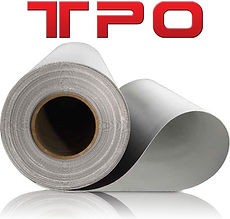
ROOFING SERVICE REPAIR QUOTES WITHIN 24 HOURS

THERMOPLASTICS
TPO & PVC
Plastic sheets welded together with hot air, creating one continuous sheet membrane. Lends itself well to both big box and small roof application because of its hot air weldability. This membrane is installed by two methods: 1.) Rolls of membrane are attached to the ridged insulation using a bonding adhesive; 2.) The edge of each roll is fastened through ridged insulation into structural deck, and the proceeding roll is lapped over the fasteners. The overlap is then heat-welded with hot air to create a mechanically fastened thermoplastic roof. PVC is also known as IB.Vinyl roof membrane

Thermoplastic olefin (TPO), or olefinic thermoplastic elastomers refer to polymer/filler blends usually consisting of some fraction of a thermoplastic, an elastomer or rubber, and usually a filler. Thermoplastics may include polypropylene (PP), polyethylene (PE), block copolymer polypropylene (BCPP), and others. Common fillers include, though are not restricted to talc, fiberglass, carbon fiber, wollastonite, and MOS (Metal Oxy Sulfate). Currently there are a great variety of commercially available rubbers and BCPP's.

Polyvinyl chloride, more correctly but unusually poly(vinyl chloride), commonly abbreviated PVC, is the third-most widely produced synthetic plastic polymer, after polyethylene and polypropylene.
PVC comes in two basic forms: rigid (sometimes abbreviated as RPVC) and flexible. The rigid form of PVC is used in construction for pipe and in profile applications such as doors and windows. It is also used for bottles, other non-food packaging, and cards (such as bank or membership cards). It can be made softer and more flexible by the addition of plasticizers, the most widely used being phthalates. In this form, it is also used in plumbing, electrical cable insulation, imitation leather, signage, inflatable products, and many applications where it replaces rubber.